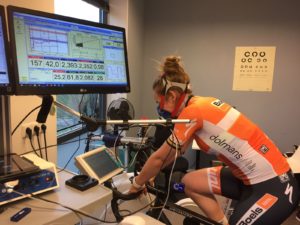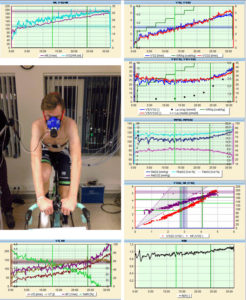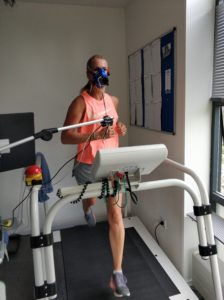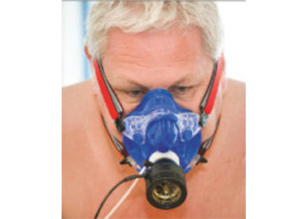The VO2max Test is a maximum stress test on a treadmill or a cycle ergometer, […]
VO2max Test
The VO2max Test is a maximum stress test on a treadmill or a cycle ergometer, whereby we constantly analyse the air you exhale. VO2max stands for the maximum oxygen intake and is generally considered the best indicator of fitness and capacity. The higher your VO2max, the more energy your body is able to produce using oxygen, and the greater your talent for endurance sports.
 During a VO2max Test, you will be breathing through a mask that is connected to the measuring equipment by two small cables. After a warm-up, we will gradually increase the cycling load or running speed up to a point where you are exhausted. We’ll maintain each stress level for 3 minutes. This is longer than the protocol used by most SMAs, which use either continuously increasing stress levels or increase the stress level every minute. We, however, not only want to measure your maximum stress level, we also want to find out what happens ‘along the way’ before you reach your maximum level. After all, you spend most of your time training at an intensity level that is (well) below the maximum you can take. Given that your body needs time to adapt to a higher stress level every time, a test protocol with shorter intervals and quickly increasing stress levels will not collect this valuable information.
During a VO2max Test, you will be breathing through a mask that is connected to the measuring equipment by two small cables. After a warm-up, we will gradually increase the cycling load or running speed up to a point where you are exhausted. We’ll maintain each stress level for 3 minutes. This is longer than the protocol used by most SMAs, which use either continuously increasing stress levels or increase the stress level every minute. We, however, not only want to measure your maximum stress level, we also want to find out what happens ‘along the way’ before you reach your maximum level. After all, you spend most of your time training at an intensity level that is (well) below the maximum you can take. Given that your body needs time to adapt to a higher stress level every time, a test protocol with shorter intervals and quickly increasing stress levels will not collect this valuable information.
Threshold (FTP) and Training zones
 Based on your breathing – the quantity and composition of the air you exhale – we are able to determine your threshold. The threshold (FTP, inflection point, anaerobic threshold) is the highest intensity you can handle for a ‘prolonged period,’ which is a key performance indicator for endurance athletes. Once the stress level during the VO2max Test exceeds your threshold, you become unable to reach a steady state in your body. You will notice this by your accelerated breathing and, of course, the feeling in your legs.
Based on your breathing – the quantity and composition of the air you exhale – we are able to determine your threshold. The threshold (FTP, inflection point, anaerobic threshold) is the highest intensity you can handle for a ‘prolonged period,’ which is a key performance indicator for endurance athletes. Once the stress level during the VO2max Test exceeds your threshold, you become unable to reach a steady state in your body. You will notice this by your accelerated breathing and, of course, the feeling in your legs.
The threshold is also what determines your individual training zones. Many heart rate monitors ‘automatically’ set heart rate zones based on the, estimated or measured, maximum heart rate. But the fitter you are, the higher your threshold in relation to your maximum heart rate (and vice versa). It is, therefore, better to determine the training zones that are specific for you, and to use those levels during your training sessions.
Cycling, running, triathlon test?
As the kind of exercise you do has a direct impact on your heart rate and training zones, testing should ideally be specific to your sport. So, if you are a runner, you should do the test on a treadmill, while cyclists should do it on the cycle ergometer. On average, a person’s heart rate while running is 10 beats faster than while cycling. That said, combined tests that include both running and cycling show that the difference can be greater in individual cases, up to as many as 20-25 beats at the threshold(s).
 For triathletes, therefore, it is advisable to determine both specific running zones and specific cycling zones. Needless to say, you can do so by doing a VO2max Test on the cycle ergometer and one on the treadmill on different days. Another option is to combine both activities during one single session.
For triathletes, therefore, it is advisable to determine both specific running zones and specific cycling zones. Needless to say, you can do so by doing a VO2max Test on the cycle ergometer and one on the treadmill on different days. Another option is to combine both activities during one single session.
The VO2max Test for triathletes is made up of two parts:
- a sub-maximum cycling (or running) test, whereby we up the stress level to just above your threshold. At that point, we stop this part of the test to avoid it having a negative impact on the second part of the test.
- a normal VO2max Test (running or cycling), where we will take you up to the maximum stress level.
During both parts of the test, we measure the air your inhale and exhale and your lactate levels to get a good reading of your specific running and cycling fitness, as well as to determine the training zones for both activities.
Lactate (lactic acid)
The lactate level reading indicates the level of acidification while exercising at a certain intensity. We can perform further lactate level measurements during a VO2max Test or Sports medical examination. For more background information, read the page about additional lactate testing.
Breathing
Endurance athletes are generally able to keep their breathing under control for a relatively long time, even above their anaerobic threshold. Consequently, looking at the respiratory rate alone, without analysing the air exhaled or testing lactate levels, is not sensible, as it may lead to major overestimation of the threshold and training zones. As generally known, continuous training at excessively high heart rate levels will result in excessive fatigue and even overtraining.
 Measuring the breathing pattern, however, is an interesting option, because some athletes breathe far from efficiently because their breathing is overly shallow. Shallow breathing is breathing with a high respiratory rate while drawing relatively little breath into the lungs. This takes both extra energy and makes exercise feel unnecessarily strenuous, as shown by a 2016 study by Nicolo. Inadequate breathing can, therefore, without having any kind of medical cause, certainly have a negative impact on performance, either directly or indirectly. For more information about improving your breathing, take a look at inspiratory muscle training (Dutch).
Measuring the breathing pattern, however, is an interesting option, because some athletes breathe far from efficiently because their breathing is overly shallow. Shallow breathing is breathing with a high respiratory rate while drawing relatively little breath into the lungs. This takes both extra energy and makes exercise feel unnecessarily strenuous, as shown by a 2016 study by Nicolo. Inadequate breathing can, therefore, without having any kind of medical cause, certainly have a negative impact on performance, either directly or indirectly. For more information about improving your breathing, take a look at inspiratory muscle training (Dutch).
Report
After the test, we will go over the “rough” results with you and give you training advice. You will subsequently receive the detailed test report specifying your training zones, reference values, and further explanation by email. To get an idea of what such a report looks like, click HERE for a sample version of part of a VO2max Test report.
Interested?
For a list of test options and prices, click HERE.
Go to the SCHEDULER to book a test.
